Chapter 3: Building Blocks
Floor and Ground Surfaces
This guide explains requirements in the ADA Standards for floor and ground surfaces. Specifications for floor and ground surfaces address surface characteristics, carpeting, openings, and changes in level. They apply to:
-
interior and exterior accessible routes, including walking surfaces, ramps, elevators, and lifts
-
stairways that are part of a means of egress
-
required clearances, including clear floor space, wheelchair seating spaces, turning space, and door maneuvering clearances
-
accessible parking spaces, access aisles, and accessible passenger loading zones.
Firmness, Stability, and Slip Resistance [§302.1]
Accessible floor and ground surfaces must be stable, firm, and slip resistant. Stable surfaces resist movement, while firm surfaces resist deformation by applied forces. Accessible surfaces remain unchanged by external forces, objects, or materials.
Hardened materials such as concrete, asphalt, tile, and wood are sufficiently firm and stable for accessibility.
Most loose materials, including gravel will not meet these requirements unless properly treated to provide sufficient surface integrity and resilience. Binders, consolidants, compaction, and grid forms may enable some of these materials to perform satisfactorily but require repeated maintenance.
Slip Resistance
Accessible surfaces must be slip resistant to minimize hazards to people with disabilities, especially those who are ambulatory or semi-ambulatory or who use canes, crutches, and other walking aids. However, the standards do not specify a minimum level of slip resistance (coefficient of friction) because a consensus method for rating slip resistance remains elusive. While different measurement devices and protocols have been developed over the years for use in the laboratory or the field, a widely accepted method has not emerged. Since rating systems are unique to the test method, specific levels of slip resistance can only be meaningfully specified according to a particular measurement protocol. Some flooring products are labeled with a slip resistance rating based on a laboratory test procedure.
Compliance with the standards requires specifying surface materials, textures, or finishes that prevent or minimize slipperiness under the conditions likely to be found on the surface. Standard practices for minimizing floor or ground slipperiness will likely satisfy compliance with the standards as slip resistance is important not just for accessibility but for general safety as well. Applications and finishes used to increase a surface material’s slip resistance may require continued maintenance or re-application.
Surface Smoothness
The standards limit changes in level and openings in floor and ground surfaces, but they do not further address overall surface smoothness. Rough surfaces composed of cobblestones, Belgian blocks, and similar materials can be difficult and sometimes painful to negotiate with wheeled mobility aids due to the vibrations they cause.
Cobblestones and other rough surfaces make wheelchair travel difficult and uncomfortable.
Recommendation: Avoid materials or construction methods that create bumpy and uneven surfaces in areas and along routes required to be accessible.
Carpet [§302.2]
Carpet that is thick, cushiony, or loose impairs accessibility, particularly wheelchair maneuvering. The standards specify the maximum pile height (1/2” measured to the backing, cushion, or pad) and texture (level or textured loop, level cut pile, or level cut/uncut pile) and require firm backing. Cushions or pads also must be firm or can be avoided to ensure greater firmness.
Carpeting must be securely attached so that it does not shift or buckle against wheeled traffic. Cushions or pads, if used, also must be properly secured to resist movement. Rolling or buckling occurs when carpet is not properly secured and makes wheelchair maneuvering very difficult.
Exposed edges must have trim on the entire length of the exposed edge and be fastened to the floor to prevent curling. Trim must meet specifications for changes in level, including requirements for beveled edges when the height exceeds ¼ inch. The maximum height is ½ inch.
Carpet Edge Treatment 1/2” max height, 1:2 max beveled edge
Carpet to Tile Transition Changes in level 1/4” max high permitted vertical edge
Openings [§302.3]
Openings in ground and floor surfaces, such as grates, are limited in width to prevent passage of a ½” diameter sphere. Wheelchair casters can get wedged into wider openings.
Surface Opening (Cross Section)
Elongated openings, like those of most grates, must be oriented so that the long dimension is perpendicular to the dominant travel direction. In locations where there is no dominant flow pattern, openings must be limited to ½” in both dimensions. Where an accessible route is available to bypass openings completely, they can be oriented in any direction.
Changes in Level [§303]
Changes in level can be up to ¼” without treatment or ½” if beveled with a slope no steeper than 1:2. Changes in level above a ½” must be treated as a ramp or curb ramp (or a walkway if a slope no steeper than 1:20 can be achieved). These specifications apply to all portions of accessible routes, including thresholds and carpet trim.
1/4” Max Change in Level
1/2” Max Change in Level
Common Questions
Must accessible surfaces be paved?
Concrete, asphalt, and other paved surfaces are more reliably compliant, but other materials, such as wood, and construction methods can be used to provide firm and stable surfaces. Loose material like gravel will not perform adequately unless it is sufficiently stabilized by binders, compaction, or other treatments and will likely require repeated maintenance.
What is the minimum level of slip resistance required by the standards?
The standards require ground and floor surfaces to be slip resistant, but they do not specify a minimum level of slip resistance or coefficient of friction. This value varies according to the measurement method and protocols used. Some products are labeled with a rated level, but in the absence of a consensus test procedure, the standards do not set a minimum value. Standard methods to prevent or minimize slipperiness in the specification of floor materials, textures, applications, and finishes may be sufficient for compliance with the standards.
Is there a minimum distance between changes in level?
The standards do not require a minimum horizontal separation between changes in level of a ½” or less. Such level changes may need to be in close proximity, such as at raised thresholds (otherwise a minimum 48” separation will provide enough wheelchair space so that only one vertical change is negotiated at a time). Ramps and curb ramps, which must be used to span vertical changes greater than ½”, must have level landings and clearances at the tops and bottoms of each run to provide adequate separation and resting intervals between sloping surfaces.
Elongated surface openings must be perpendicular to the dominant direction of travel, but what if there is no dominant direction of travel?
When there is no dominant direction of cross traffic, openings must be limited to ½” in both dimensions. Where space allows accessible routes to completely bypass the area with openings, elongated openings can be oriented in either direction.
Clear Floor or Ground Space and Turning Space
This guide explains requirements in the ADA Standards for clear floor or ground space and turning space. Clearances are required at accessible elements, fixtures, and controls so that people with disabilities, including those who use wheelchairs, can approach and use them. The standards also address maneuvering space for wheelchair turning. Provisions throughout the standards reference these basic “building block” requirements.
Clear Floor or Ground Space [§305]
Sufficient clear floor or ground space is required at accessible controls, operable parts, drinking fountains, lavatories and sinks, ATMs and fare machines, appliances, beds, and other elements. Provisions for these elements apply the clear floor or ground specifications in 305.
Clear Floor Space at Elements
Clear floor space is required at each accessible element, including storage cabinets, drinking fountains and other fixtures, and electrical outlets. Clear floor spaces can overlap where elements are in close proximity.
Position [§305.5]
At most elements, clear floor or ground space can be positioned for either a forward or a side approach. For better usability, a forward approach is required at certain elements, including dining and work surfaces, drinking fountains, lavatories, and most sinks. At other elements, a side approach is allowed. A side approach is typically provided or required at sales and service counters, beds, and most appliances.
Forward Approach
Side Approach
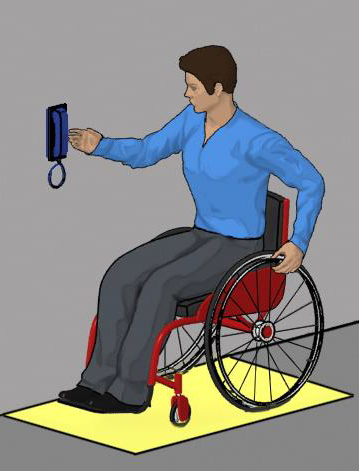
Centering
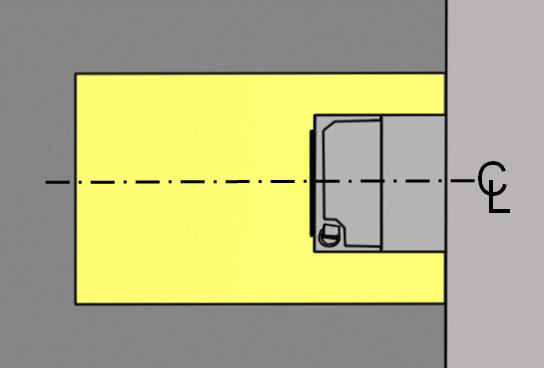
Centering the clear floor or ground space on elements is often advisable but is only required at drinking fountains, kitchen work surfaces, and washers and dryers.
Surface and Size [§305.2 and §305.3]
Clear floor spaces must meet requirements for ground and floor surfaces, including criteria for firmness, stability, and slip resistance. They must be free of level changes and not slope more than 1:48.
The minimum size (30” by 48”) applies whether the space is positioned for forward or side approaches. Additional space is required when the space is confined on three sides and is obstructed for more than half the depth, such as when elements are recessed in alcoves.
Approach and Maneuvering Clearance [§305.6 and §305.7]
Where the space is obstructed on both sides for more than half the depth, additional clearance is required for maneuvering. Accessible routes must connect to the unobstructed side of the space.
Knee and Toe Space [§305.4 and §306]
Objects that provide space for toes or knees can overlap a portion of the clear floor space. Knee and toe space allows a closer approach to elements and reduces the reach to operable parts. It is required at some elements, such as drinking fountains and lavatories, so that people using wheelchairs can pull up to them.
Toe Space
Objects that provide clearance for toes can overlap a portion of the clear floor space.
Knee Space
Objects that provide clearance for knees and toes can overlap a greater portion of the clear floor space (up to a depth of 25”).
Knee and toe space must be at least 30” wide and up to 25” deep measured to the leading edge of the clear floor space. The specifications allow space for plumbing, enclosures, and supports outside the minimum clearances. No object can protrude into the required clearances (other than the dip of the overflow at lavatories and sinks).
Knee and Toe Space Depth
Where knee and toe space is required, it must be at least 17” deep. In all cases, the minimum depth may be further determined by the required reach to operable parts served by the clear floor space.
Knee and toe space is required below drinking fountains, lavatories and sinks, dining and work surfaces, and those sales and service counters that provide a forward approach.
Obstructed Reach Depth
At any element, the knee and toe space must be as deep as the required reach to operable parts. This facilitates access since a forward reach does not extend far beyond the toes. Both the reach depth and the knee and toe space depth are limited to 25” measured from the leading edge of obstructions. Space beyond this depth is not usable.
Knee and Toe Clearances
Where knee and toe space is required at an element, it must be at least 17” deep. Beyond a depth of 8” measured from the leading edge, the 27” minimum high knee clearance can reduce 18” (to the 9” toe space) over a 3” span.
When the knee and toe depth exceeds the 17” minimum, the additional space must provide full knee clearance at least 27” high.
Turning Space [§304]
Turning space is required in these accessible rooms and spaces:
-
toilet and bathing facilities
-
dressing, fitting, and locker rooms
-
transient lodging guest rooms
-
dwelling units (all rooms on an accessible route)
-
patient bedrooms
-
holding and housing cells
-
saunas and steam rooms
-
raised courtroom stations served by ramps or lifts with entry ramps
-
certain recreation spaces (amusement ride load/ unload areas, fishing piers and platforms, play components, and shooting facilities)
Space for turning is also required along accessible routes where a 180 degree turn around an obstruction less than 48” wide is required (§403.5.2).
Clear Width at 180 Degree Turn Around a Narrow Obstruction
Recommendation: Turning space is recommended in small spaces with entrapment risks as well as at dead-end aisles and corridors so that people using wheeled mobility aids do not have to back up considerable distances.
Maneuvering for Turns
Maneuvering for 180 degree turns varies by person and the mobility aid used. An efficient way of turning using a manual wheelchair is to turn the wheels in opposite directions for a pivoting turn. Some power chairs also may permit tight circular turns.
A three-point turn is common when using scooters and other motorized devices that have a larger turning radius.
Size [§304.3]
Turning space can be provided in the shape of a circle or a T. Elements with knee and toe space can overlap a portion of the turning space.
Circular Turning Space
Recommendation: To provide easier access, locate elements with knee and toe space outside the turning space or, with circular space, limit overlap to approximately 12” so that wheelchair space 48” long minimum remains clear.
T-Shaped Turning Space
T-shaped space can be configured for approach on any segment (stem or either arm).
Door Swing [§304.4] and Other Space Requirements
Doors can swing into the turning space. The turning space can overlap other space requirements, including clear floor space required at elements and fixtures.
Common Questions
Is clear floor space required to be centered on elements?
The standards require the clear floor space to be centered on wheelchair accessible drinking fountains (forward approach), kitchen work surfaces, (forward approach), and washers and dryers (side approach). Centering the clear floor space on other elements is often advisable, but not required.
Can doors swing into required clear floor or ground space?
Doors cannot swing into required clear floor or ground spaces in these specific instances:
-
clear floor space at controls for automatic and power assisted doors and gates (404.3.5)
-
fixture clearances in toilet and bathing facilities (except those that are single user where wheelchair space beyond the door swing is provided) (603.2.3)
-
clear floor space required at benches in saunas and steam rooms (612.2)
-
clear floor space required at tactile signs, which must be beyond the arc of any door swing between the closed position and 45 degree open position (703.4.2)
-
dressing, fitting, or locker rooms unless wheelchair space is provided beyond the arc of the door swing (803.3)
In other locations, doors can swing into clear floor or ground space, although locating door swing outside required clearances is advisable.
Can doors swing into turning space?
Yes, doors can swing into turning space.
Can clear floor/ground space or turning space overlap other space requirements?
Yes, clear floor or ground spaces and turning space can overlap other required clearances, including other clear floor spaces, door maneuvering clearances, and fixture clearances.
Is turning space required in all rooms and spaces?
No. Turning space is required in certain spaces, such as toilet and bathing facilities, dressing and fitting rooms, and transient lodging guest rooms. Unless addressed by a specific requirement for turning space in the standards, other spaces are not required to provide them, including lobbies, offices, and meeting rooms.
Operable Parts Covered [§205]
Compliance is required for operable parts located in accessible spaces and along accessible routes. Operable parts include light switches, electrical and communication receptacles, thermostats, alarm pulls, automatic door controls, and other elements used by facility occupants.
Examples of Operable Parts
Examples of Operable Parts in Kitchens
Operable Parts [§309]
Requirements apply generally to all types of operable parts covered. They are also referenced by technical sections of the standards covering drinking fountains, faucet and flush controls, ATM and fare machines, appliances, storage, windows, and door and gate hardware, and other elements.
Accessible Features of Operable Parts
Forward and Side Approaches
At most elements, clear floor space can be positioned for either a forward approach or a side approach. A forward approach is required at some elements, such as drinking fountains and lavatories, for easier access.
Clear Floor Space [§309.2]
Clear floor space for forward approaches must extend up to or, if knee or toe space is provided, below operable parts. This facilitates access since the forward reach does not extend beyond a wheelchair user’s toes.
If clear floor space is obstructed on both sides more than half the minimum required depth, a wider clearance (36” min.) is required for maneuvering and sway.
Knee and Toe Space
If the forward reach to operable parts extends over an obstruction, such as a counter, clearances for toes and knees is required below. The knee and toe space must be at least as deep as the reach depth measured from the leading edge of the obstruction.
Forward Reach [§308.2]
The range for unobstructed reaches (15” – 48”) applies only to those portions of elements that are operable. Non-operable portions can be located outside the range.
Obstructed High Reach
The maximum reach of 48” is reduced to 44” when the depth of reach over an obstruction exceeds 20.” Knee and toe space must extend the full depth of reach.
Clear Floor Space [§309.2]
Clear floor space can be oriented for a side approach instead of a forward approach at most operable parts. Nominal centering of the space on operable portions of elements is advisable, but not required (except at washers and dryers).
Clear Floor Space
Additional clearance is required if the space is obstructed on three sides for more than half the depth to allow easier maneuvering into the space.
Side Reach [§308.3]
The range for side reach, like forward reach is 15” to 48” if unobstructed. The maximum reach depth for this range is 10” measured from the available clear floor space.
Fuel Dispensers
The operable parts of fuel dispensers located on existing curbs can be up to 54” high.
The maximum high reach is reduced to 46” when the reach over an obstruction is deeper than 10” (to a maximum of 24”). Obstructions at side reaches are limited to a height of 34”.
Elements located in corners can be difficult to reach from a side approach.
Recommendation: Where a side reach is provided, locate elements away from corners in consideration of the typical reach radius.
Advisory Reach Range for Children
The standards include advisory (non-mandatory) reach ranges based on children’s dimensions that can be followed when operable parts are designed for use by children. This guidance provides reach ranges recommended according to three age groups.
Operation [§309.4]
Operable parts must be usable with one hand and not require:
-
tight grasping, pinching, or twisting of the wrist, or
-
more than 5 pounds of force (lbf) to operate.
Parts that can be operated without hand or finger dexterity, fine motor movement, or simultaneous actions provide easier access and accommodate a broader range of users.
Operability with a closed fist is a reliable test of usability, but is not required by the standards.
Push Plates, Buttons, and Bars
Push-activated controls not requiring more than 5 lbf are acceptable. Buttons that are raised or flush are easier to use than those that are recessed. (Elevator control buttons cannot be recessed, and input keys at ATM and fare machines must be raised.)
Handles, Pulls, and Knobs
Standard U-shaped pulls and lever-shaped handles are acceptable. Stationary knobs with a shape that can be loosely gripped also are acceptable. Knobs that require a full hand grip and turning, including round door knobs and shower controls, do not comply because they require twisting of the wrist.
Latches and Locks
Latches and locks with small parts that must be manipulated can be difficult to use and will not comply if pinching is necessary. However, non-fixed portions of locks and other operable parts, such as keys and access cards, are not required to comply (but those that do not require pinching or turning provide better access). Hardware that does not require simultaneous actions are better, but some types, such as handles with thumb latches are acceptable.
Controls and Switches
Dials and other controls that can be turned with the fingers but not the full hand can be used if they do not require twisting of the wrist or pinching. Flip switches and similar controls are acceptable, though push plate types can provide easier access.
Common Questions
Are redundant controls for an element required to comply?
If redundant controls, other than light switches, serve a single element, one control in each space is not required to comply. If a redundant control is located in a different space, however, it must comply. All light switches are required to comply.
What types of electrical or communication receptacles are exempt because they serve a “dedicated use”?
Electrical receptacles serving a dedicated use include those installed for appliances, including refrigerators, ranges, and dishwashers, and wall clocks. Floor electrical receptacles are also exempt. Communication receptacles serving a dedicated use include phone jacks, data ports, network and audio-visual connections. Electrical receptacles provided for portable communication devices such as TTYs are not covered by this exception and must comply.
Do reach range requirements apply to elements or only to operable parts of elements?
Reach range requirements apply to the operable portions of elements, including handles, controls, switches, buttons, control pads and other mechanisms that must be activated or manipulated for use. Non-operable portions of elements do not have to be within accessible reach ranges.
Must operable parts be usable with a closed fist?
Closed-fist operation is a good performance test but is not required by the standards. Many types of operable parts, such as pull handles, satisfy the requirements even though they may not be operable with a closed fist.
Are turn-key locks prohibited by the standards?
Key locks or key cards are not prohibited by the standards which apply only to the fixed portions of operable parts. Similarly, items dispensed by ATMs and fare machines, such as receipts, cash, fare cards, and vending machine products are not covered by the standards.
Protruding Objects [§204]
To prevent hazards to people with vision impairments, the standards limit the projection of objects into circulation paths. These requirements apply to all circulation paths and are not limited to accessible routes. Circulation paths include interior and exterior walks, paths, hallways, courtyards, elevators, platform lifts, ramps, stairways, and landings.
Examples of Protruding Objects
Protrusion Limits [§307.2]
People with vision impairments often travel closely along walls which can provide wayfinding cues sometime called a “shoreline.” Objects mounted on walls, partitions, columns, and other elements along circulation paths can pose hazards unless their projection is limited. Those with leading edges that are within cane sweep (27” high maximum) or that provide minimum headroom clearance (80” minimum) do not pose hazards and can protrude any amount.
Limits of Protruding Objects
Protruding object limits apply to the full width of circulation paths.
Location Above Detectable Elements
Objects located above elements that are within can sweep can protrude 4” maximum from the leading edge of such elements provided that any required reach or clear floor space is not obstructed.
Side Partitions and Wing Walls
Side partitions or panels and wing walls can also be used to make protruding objects compliant. The bottom edge of panels or partitions must be 27” high maximum.
Recessed Objects
Objects can be recessed in alcoves so that they do not project more than 4” into circulation paths. Alcoves must be sized to accommodate required clear floor space at accessible elements.
Elements, such as wheelchair accessible drinking fountains, must provide a knee clearance of at least 27”. If located to provide, but not exceed this clearance (27” above the floor or ground absolute), they are not protruding objects because the leading edge will be within cane detection.
A wheelchair accessible unit located 27” absolute above the ground or floor is cane detectable and can be used to enclose one side of high units for standing access. In this instance, the 27” height is effectively an absolute dimension because it is the minimum required for knee clearance and the maximum specified for cane detection.
Post-Mounted Objects [§307.3]
Free-standing objects with leading edges 27” to 80” high that are mounted on posts or pylons cannot protrude more than 12” into circulation paths. The 12” limit also applies to the clearance between multiple posts (excluding the sloping portions of handrails).
Objects with leading edges 27” maximum or above 80” can protrude any amount from posts or pylons.
Vertical Clearance [§307.4]
Headroom clearance of at least 80” high is required along all circulation paths (except at doors and doorways where a 78” minimum clearance is permitted to accommodate door stops and closers).
Fixed barriers, such as guardrails, are required where the vertical clearance is less than 80” such as at open stairways and along sloped or curved walls. Barriers must have leading edges no higher than 27” so that they are within cane sweep. Fixed planters, benches, and other elements can be used instead of guardrails.
Barriers at Circulation Areas with Reduced Vertical Clearance
Reduced Clearance Below Stairway
Clearance Reduced at Curved (or Sloped Walls)
Recommendation: A minimum height is not specified for barriers demarcating areas with less than 80” of vertical clearance. It is recommended that barriers be high enough so that they are not mistaken for a step or other change in level and do not pose a tripping hazard.
Common Questions
Are requirements for protruding objects limited to hallways and corridors?
No, requirements for protruding objects apply to all circulation paths, including those in rooms and spaces off corridors. They apply to both interior and exterior circulation paths.
Do drinking fountains pose hazards as protruding objects?
Cantilevered units at standard heights for people who stand must be recessed or protected as protruding objects. This is not required for wheelchair accessible units with no more than a 27” clearance below (the minimum required for knee clearance and the maximum recognized for cane detection).
Can curbs be used to indicate areas with less than 80” of vertical clearance?
The standards specify a maximum height (27”) for the leading edge of barriers so they are within cane sweep, but a minimum height is not specified. Curbs may be mistaken for a step or change in level, instead of a barrier. For this reason, barriers significantly higher than a curb or riser, such as a guardrail, planter box, bench, parapet wall, or similar elements are recommended.


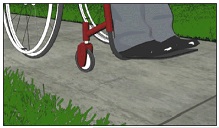
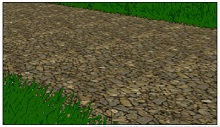

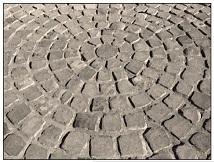

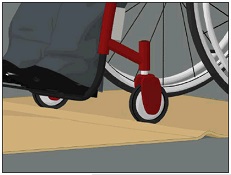


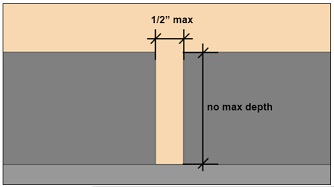
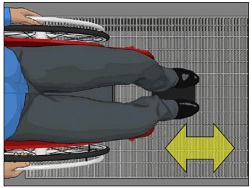
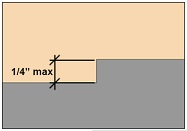
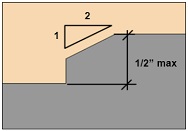


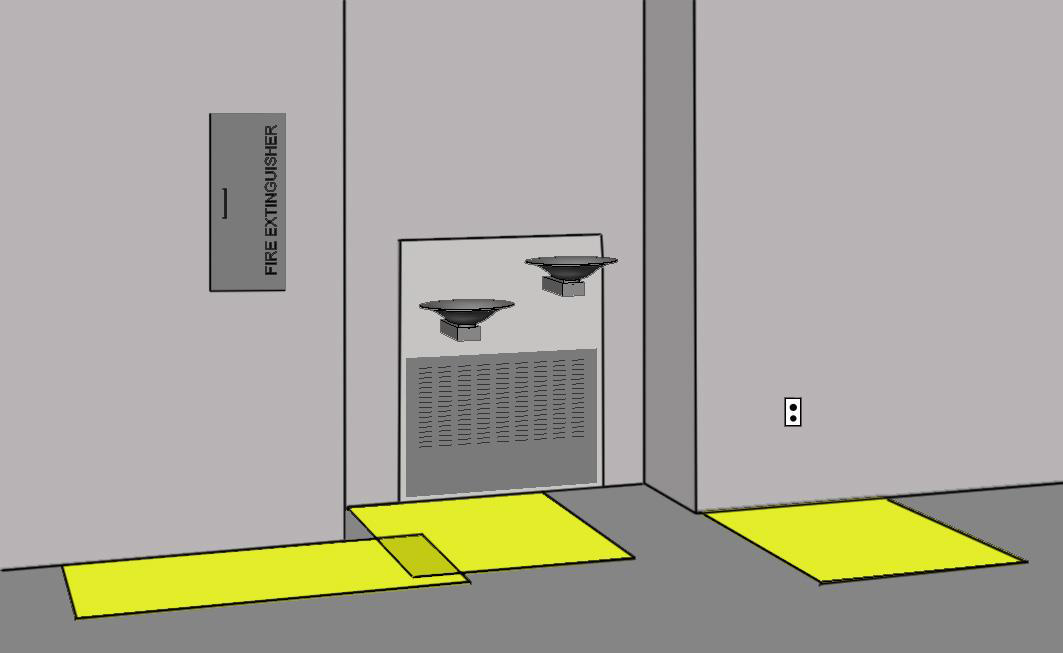
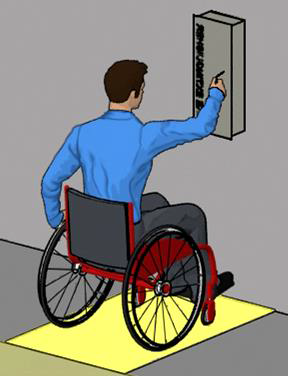
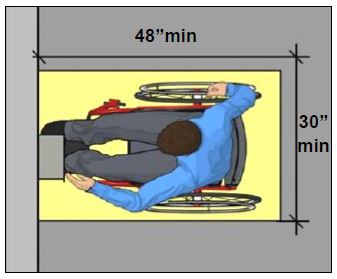
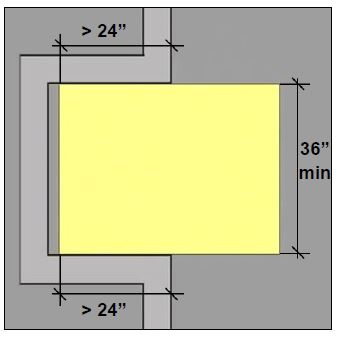
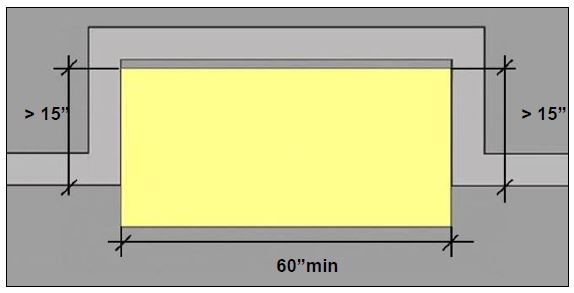
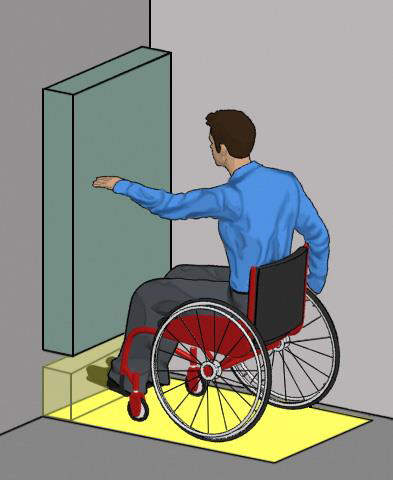
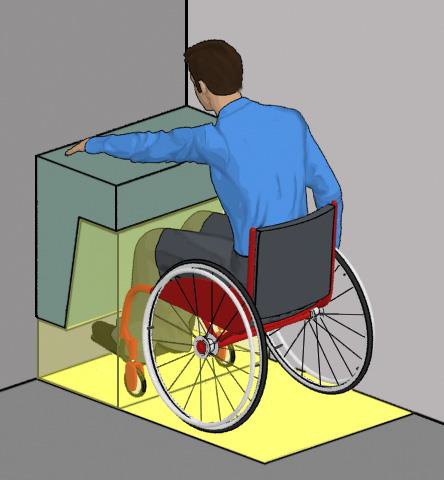
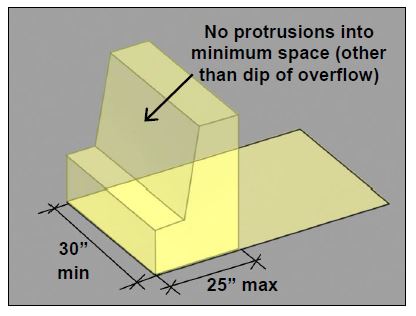
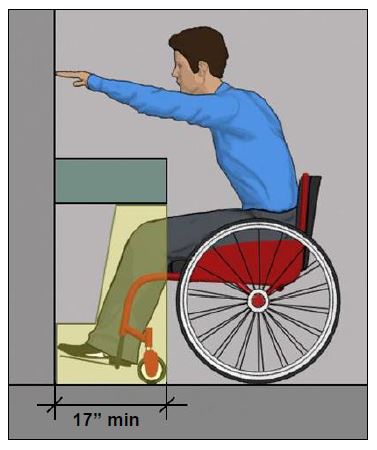

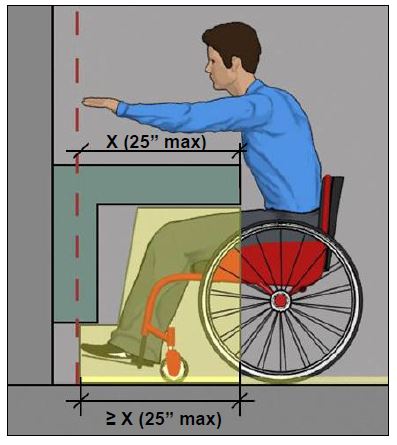
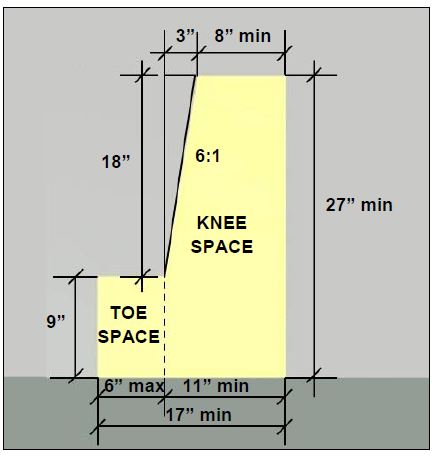
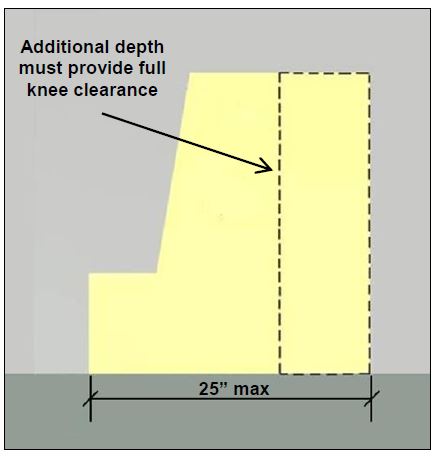
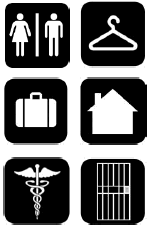
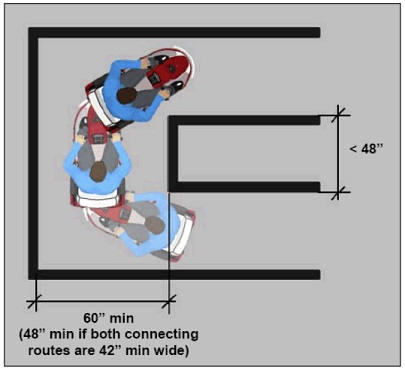

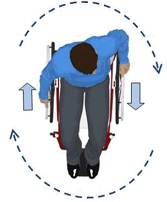
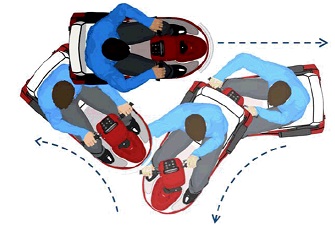
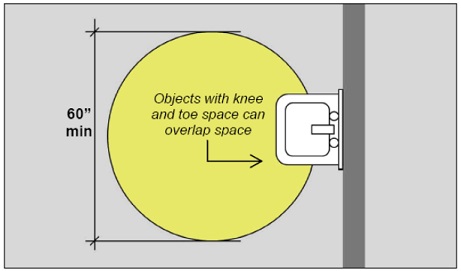

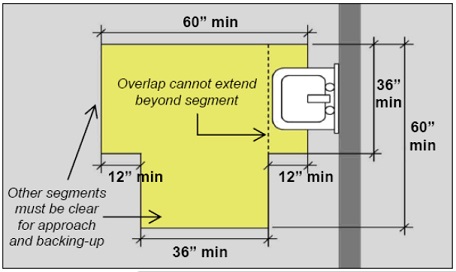
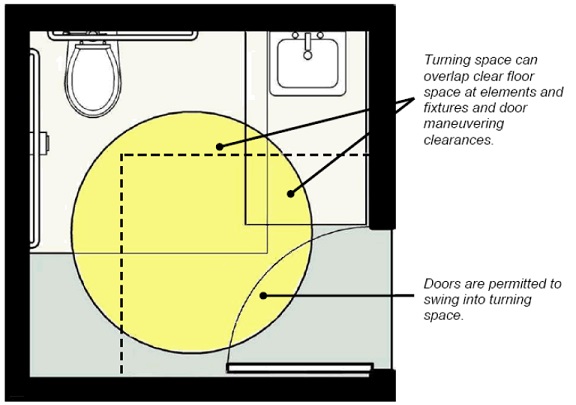

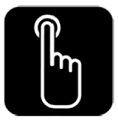
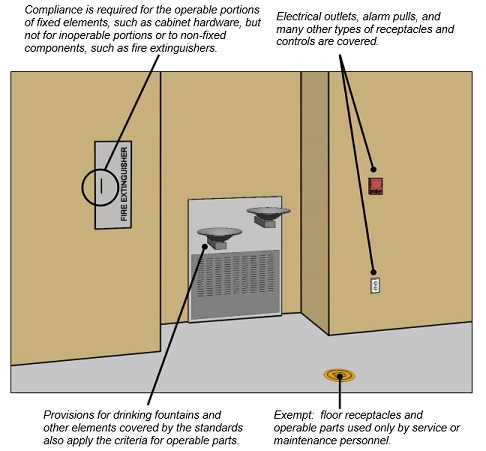
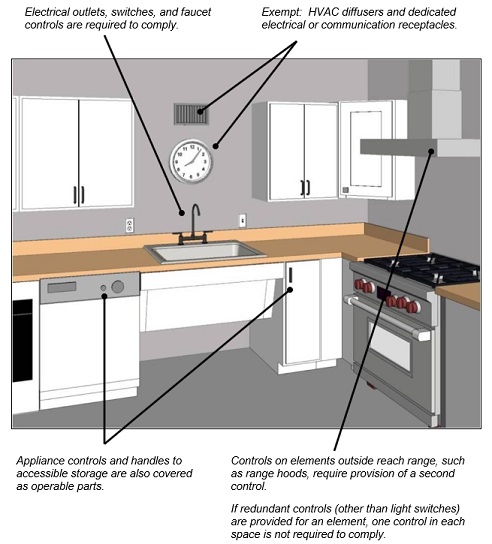
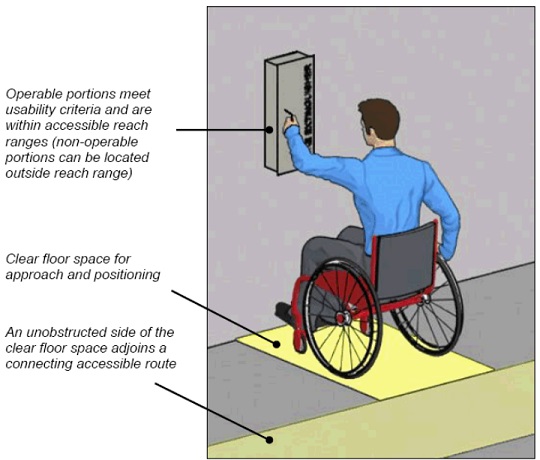
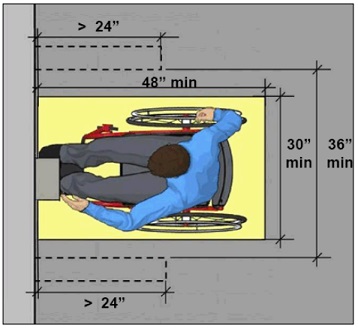
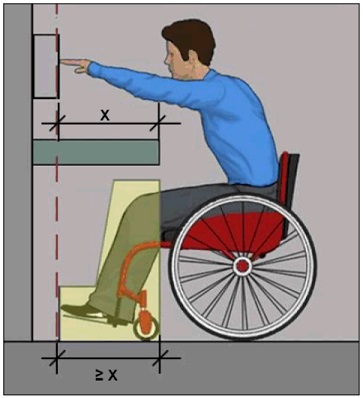
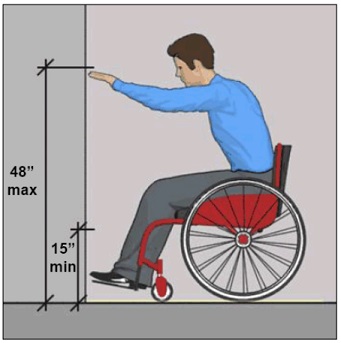
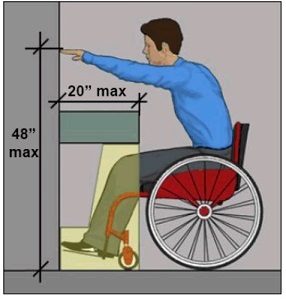
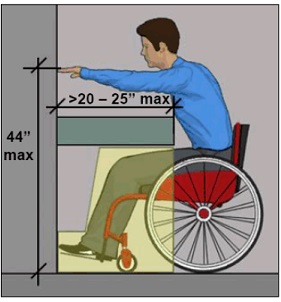
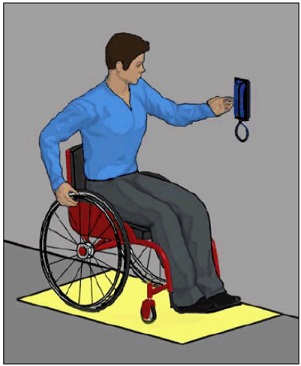
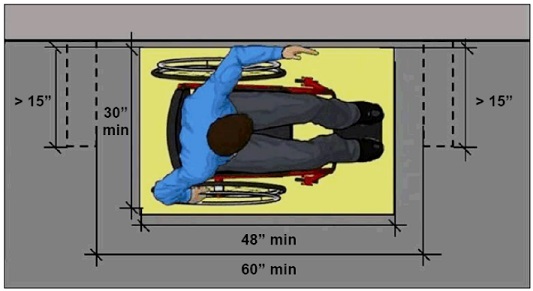
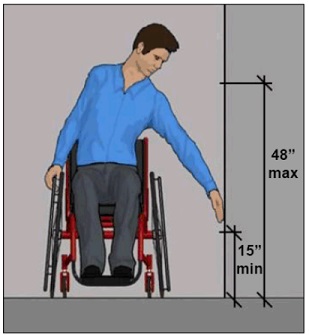

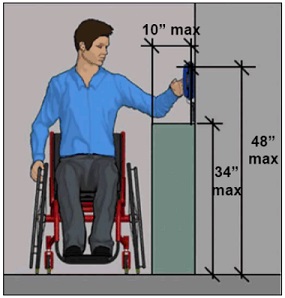
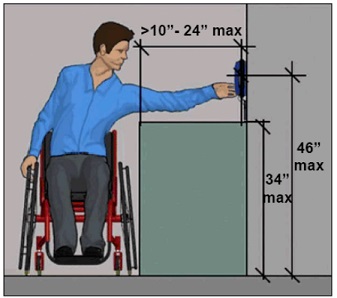

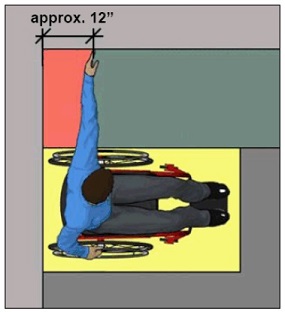
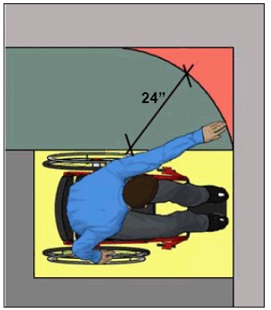
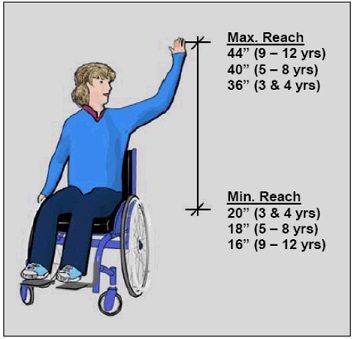
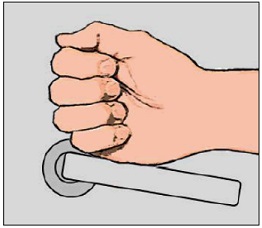





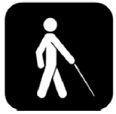
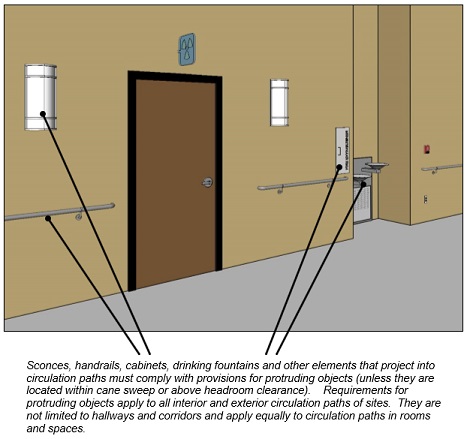
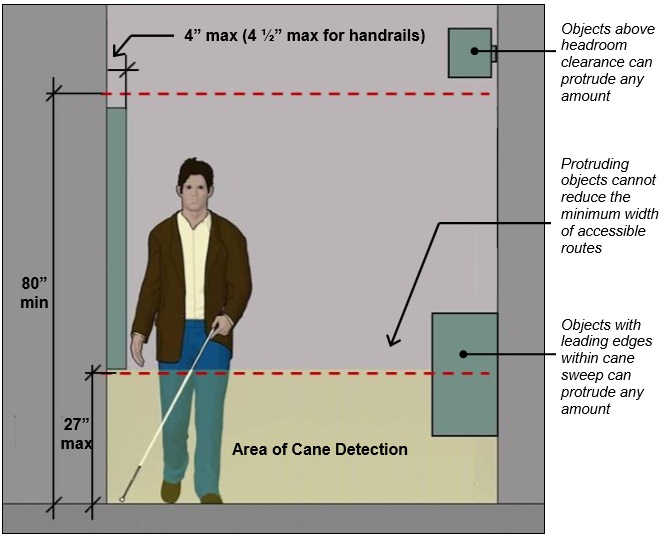
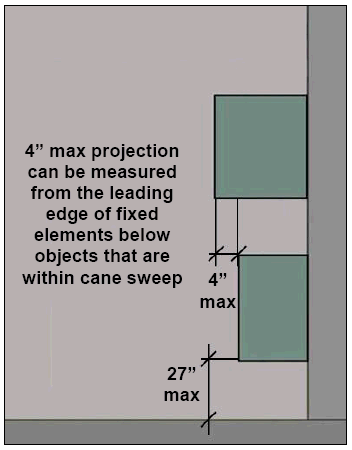
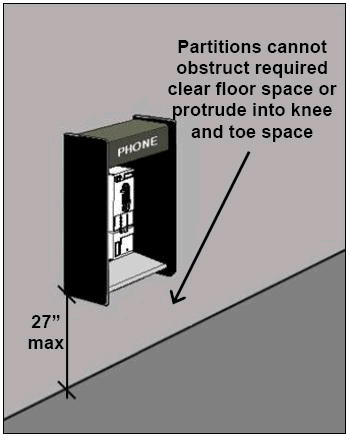
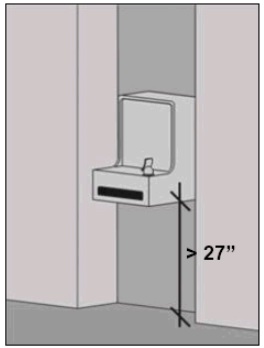
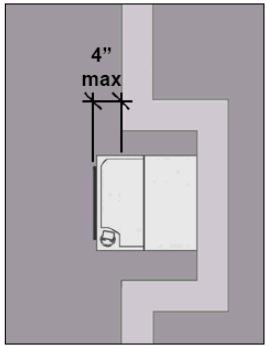
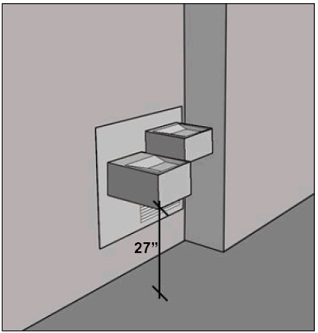
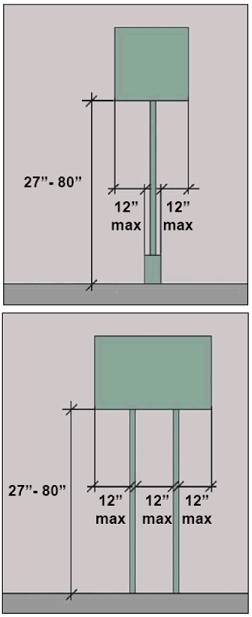
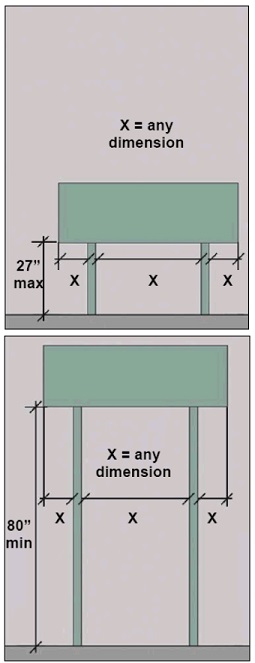
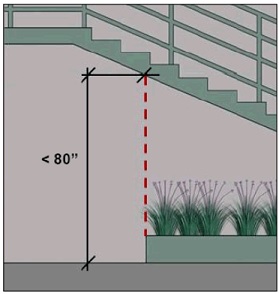
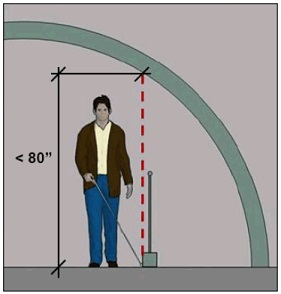


User Comments/Questions
Add Comment/Question